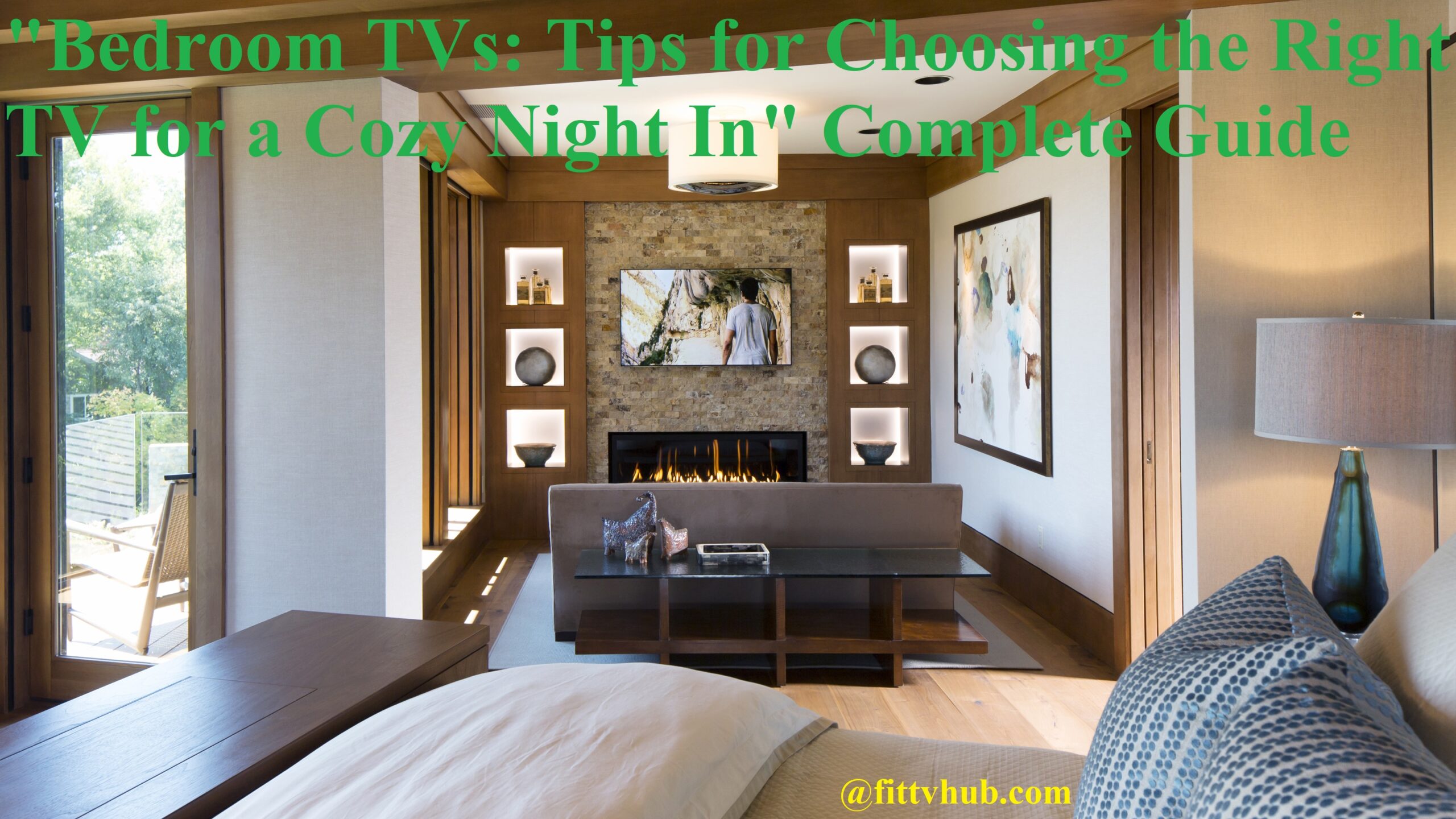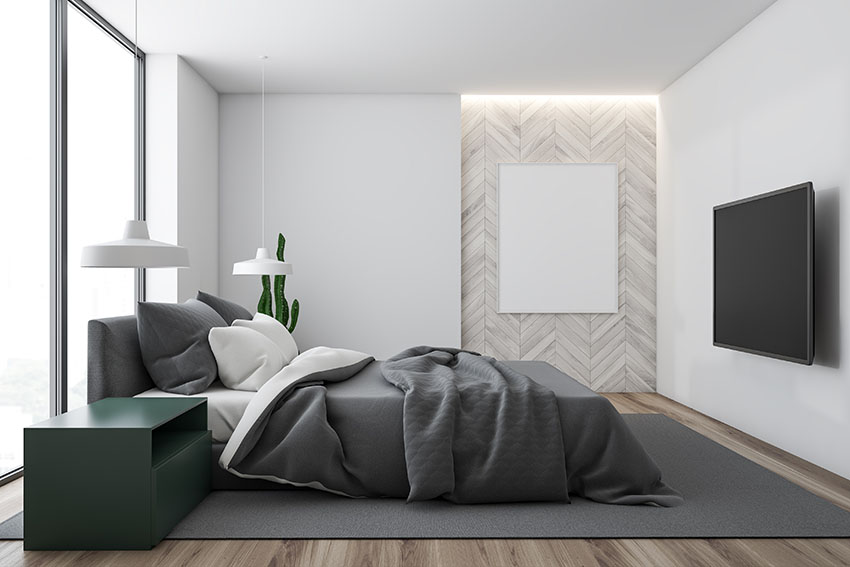Do you struggle to find the perfect TV for enjoying a quiet night at home? You’re not alone!
This guide offers expert advice on selecting the best bedroom TV, ensuring that your cozy night in is enjoyable and stress-free. Let’s get started!
If you’re looking for the best TV viewing experience to enjoy during cozy nights in, then you’re in luck! With today’s technology, there are countless options to choose from so selecting the right TV for your bedroom can be quite a task.
To make it a bit easier, we have put together this comprehensive guide on everything you need to know when choosing a bedroom TV. Here we discuss factors such as size and placement, performance features, input types, wireless compatibility and more. We provide helpful tips on planning the perfect setup for your bedroom space and tips on how to maximize your viewing experience with any budget.
So whether it’s streaming movies or enjoying shows from cable or satellite network channels, this guide will give you the information you need to help select the perfect TV for your bedroom entertainment!
Importance of having a TV in the bedroom
Having a TV in the bedroom is becoming increasingly popular for a variety of reasons. Not only does it provide entertainment and an escape from the stresses of life, but it can also help create an atmosphere for winding down after an energizing day. As TVs become more advanced with features like Wi-Fi enabled Smart TVs and 4K displays, there are now endless options to choose from when it comes to selecting the perfect bedroom television. When deciding on what type of television to purchase, it is important to consider size, resolution and budget among other factors that make each model unique.
In addition to adding a cozy feel and plenty of visual interest, having a TV in the bedroom can encourage more restful sleep because it gives one space to relax and tune out the world while watching favorite shows or movies. By reducing background noise, TVs provide a space for comfort and distraction that can help us relax before going to bed. Therefore, finding the right television set with industry standard technology such as Ultra High Definition (UHD) or High Dynamic Range (HDR) will ensure that you enjoy optimal picture quality when streaming films or gaming long into the night.
Finally, TVs equipped with features such as Bluetooth connectivity make sharing movies between devices easier than ever before – making those late night Netflix marathons all the more enjoyable! With this guide we hope you will be able to decide on which model is best suited for your cozy nights spent indoors in front of your new television set!
Purpose of the guide
This guide provides a step-by-step guide to selecting the right TV for a cozy night in. Whether you’re watching movies, shows, playing video games or just catching up with friends, having the right TV for your bedroom can make all the difference in creating a relaxing atmosphere.
This guide covers what to consider when shopping for a bedroom TV to suit your needs, from size and type of display to sound quality and picture quality. By taking the following steps into consideration you’ll be able to find the perfect bedroom TV for an enjoyable evening at home with friends or family.
Features to Look For in a Bedroom TV
When it comes to bedroom TVs, there are certain features that you should be looking for if you want to get the most out of your viewing experience. The first thing to consider when choosing a bedroom TV is size. You’ll want a TV that is big enough to be enjoyed from a comfortable viewing distance, but not so big that it’s constantly taking up space in your bedroom or dominating the atmosphere. Most experts recommend finding an HDTV with a screen between 32 and 65 inches for a bedroom setting.
Another factor to consider when purchasing a TV for your bedroom is resolution. High-definition TVs offer 1080p resolution, which produces better image quality than lower resolutions such as 720p and 480p models. If you plan on streaming content with your TV, look for models with the latest streaming technologies such as HDMI or Wi-Fi compatibility. Finally, check for TVs with HDR (High Dynamic Range) support; this technology improves image contrast and saturation to make colors more vibrant than ever before.
In general, LED backlight technology is best for bedrooms because it doesn’t produce excessive warmth or noise levels like some LCD televisions do. If you have an especially small room or budget constraints, older plasma TVs may also be an option since they tend to weigh less than LED models and can sometimes offer sharper images at comparable price points.
Picture quality
When it comes to selecting a bedroom TV, picture quality is key. You want a TV that will be able to provide you with great visuals, regardless of where you’re sitting in the room. Look for TVs with technologies like LED screens and high-definition resolutions such as 1080p or 4K Ultra HD. LED screens are far more efficient and have better color accuracy than traditional LCD screens.
Higher dynamic range (HDR) technology is an important component for better picture quality — it enhances contrast and the overall brightness of images, delivering bolder colors, even in dark scenes. Multiple HDMI ports are also useful if you plan on connecting various types of devices such as DVD players and video game consoles to your bedroom TV. Consider TVs with advanced technologies like Smart TVs or True-Motion programming for maximum convenience.
Refresh rate
Refresh rate is a concept used to quantify how quickly a TV can display new images. Essentially, refresh rate measures the amount of times per second that the television refreshes its image. The refresh rate on traditional TVs is typically 60 Hz (hertz) which means that they can refresh their images up to sixty times per second.
The higher the hertz, the more smoothly video will be displayed and you will generally notice less “judder” or lack of clear images during fast sequences.
Modern televisions have become equipped with high-refresh-rate displays, ranging from 120 Hz to 240 Hz and even higher in some cases. If you are primarily watching movies and television in a dark room or during a cozy night in, then you should consider investing in a higher refresh rate TV for improved picture quality.
Higher rates reduce motion blur when tracking action scenes, allowing images to look sharp and crisp even during moving scenes or when panning across wide landscapes. Additionally, if you enjoy playing video games then you will benefit from choosing a TV with high-refresh rates as the smoother performance helps make fast-paced game play more enjoyable.

HDR support
High Dynamic Range (HDR) support is an important feature to look for when choosing the right TV for a cozy night in. With HDR, you can enjoy an even greater range of contrast and brightness, allowing you to experience better picture quality with brighter whites and richer colors.
HDR content also offers wider color gamuts, so you can enjoy a more vivid viewing experience. Since HDR TVs require specific support for the format, make sure you check before buying that your chosen model is compatible with HDR content.
With this feature, you can enjoy beautifully rendered images from your favorite streaming services or other sources of content.
Input lag
One of the most important specifications to take into consideration when looking at TVs, especially if you plan to use yours for gaming, is input lag. This affects how quickly the TV can respond to a given input — in the case of gaming, a controller button press — and process it on screen. Lower input lag means a better gaming experience with less unsightly delays between commands issued by the player and what gets played in game.
Generally speaking, LCD and OLED TVs have good response times and have increasingly improved over time as newer models have been released. It’s important to look for this factor in particular if you plan on playing video games on your bedroom TV as it will make all the difference when it comes to responsiveness in-game.
Connectivity options
When shopping for a bedroom TV, it’s important to pay attention to the connectivity options. A variety of inputs are available, and depending on what devices you want to connect to your television, you’ll need the right type of port.
HDMI is the most common type for digital audio and video signals, streaming, gaming consoles and other devices. Component inputs have three connectors for audio and video processing; composite cables have both audio and video signals in one cable. Other connection types include VGA, which is primarily used for computers with LCD or LED monitors; S-Video (a smaller version of component video); optical digital audio output (connect it directly to a home theater system); analog audio output (headphones or speaker systems); home network access (via an Ethernet port).
To make sure all your favorite content is accessible, be sure to check the ports that come with each TV so you can get the right model that provides access to everything you want.
Maintenance and Care for the Bedroom TV
When it comes to taking care of the TV that you finally choose for your bedroom, there are some important considerations that should not be overlooked. Periodic dusting and wiping will help keep your TV in top working condition, as well as the area around it. Secondly, do not place any heat sources such as lamps or other electronics near the TV. This could damage the television’s internal components, and possibly cause a fire hazard if left unchecked for extended periods of time.
Additionally, plugging in too many devices into your bedroom TV’s power strip could overload its circuitry and potentially cause major short-circuits. Finally, take extra precautions when installing various components or wall-mounting brackets; improper mounting might lead to accidents or damage to both the flat screen and your wall itself if not installed correctly.
After taking these necessary steps towards safe usage and maintenance of a bedroom television, you can make sure that you fully enjoy those cozy nights in without worrying about any future accidents caused by negligence or recklessness.
Cleaning the TV
Keeping your bedroom TV clean is essential to enjoy a clear, crisp picture. You may not realize the difference that dirt, dust, and fingerprints can make until you clean the TV and witness the improved clarity.
To keep your TV in top shape, cleaning it thoroughly no more than once a month with a static-free cloth is recommended. Do not spray directly onto the television — instead, lightly dampen a corner of the cloth with water or glass cleaner. Too much liquid and over-rubbing can create unwanted scratches or leave behind an undesirable soapy residue. Be sure to power off and unplug your television before you start cleaning it to avoid potential static shocks.
Remember that most televisions feature delicate screen coatings and finishes, so always handle carefully and use only non-abrasive materials when cleaning. For tough stains such as smudges from greasy hands or makeup residue, use some form of polishing agent such as Renegade reusable glass wipes or ammonia-free cleaners such as Windex foaming glass cleaner. There are also several products on the market specifically manufactured for LCD, LED/QLED TVs for superior image quality protection – be sure to determine what type of television screen you have before using any wet cleansing products on it!
Preventing screen burn-in
Screen burn-in is a form of permanent damage that can occur to a TV screen if there is static image, such as a logo or menu, displayed for too long. It occurs when the individual pixels become faded and stuck showing an imprint of that image. To prevent this from occurring, new TVs feature technologies such as pixel-shifting or auto-rotating of images.
Additionally, you should take steps to ensure that your TV isn’t displaying static images for extended periods of time; you can turn off the TV when not in use, set background colors in menus to black instead of white, and avoid leaving games paused on the screen. Additionally, changing channels regularly can help prevent screen burn-in issues.
Finally, some TVs offer special modes known as “screen savers” that display slowly moving colors or images and can reduce wear on pixels over time.
Troubleshooting common issues
Being able to troubleshoot common issues with a bedroom TV is key when deciding on the right television for a cozy night in. It can save you from having to wait and call a repairman if anything goes wrong. To avoid this, make sure you are familiar with the issues that could potentially arise and how best to solve them. Here are some of the most common issues you may run into and how to fix them.
- Picture Quality: One of the most common complaints about bedroom TVs is the picture quality, which can become dull and discolored over time. This can be fixed by calibrating your TV’s settings according to your viewing environment—such as selecting an appropriate color temperature or support for HDR content—or by setting up a color profile on newer TVs, which may require calibration equipment. Also check whether buffering or low bandwidth could be causing streaming content to look out-of-sync or pixelated. You should also make sure that all cables (such as HDMI) are securely connected and free from dust, dirt, and other obstructions.
- Audio: Poor audio quality can be caused by incorrect speaker settings on the TV, such as an inappropriate sound mode or surround sound settings that don’t match your speaker setup; environmental factors such as multiple audio output devices; faulty cables; or an issue with your receiver (if you have one). It’s important to remember that bedroom TVs will typically require external speakers for optimal sound quality; internal speakers are unlikely to provide satisfactory results due to their small size and limited power output*. If none of these remedies work, then it may be worth checking whether there is any software update available for your system that could potentially improve performance in this area.
- Signal: If signal reception is weak or unreliable, then try moving the antenna closer to a window or outdoors if possible; use cable extensions (for coaxial) if necessary; use signal amplifiers for better reception at longer distances from signal towers; reorient directional antennas until reception is reliable*; place indoor antennas higher up near windows*; recheck settings such as channel scanning in case they were incorrectly configured previously* (note that these steps may slightly differ between different manufactures); consider switching TV providers where necessary*.. These methods should help improve signal reception while keeping installation costs fairly low compared to professional repair services*.
**NB: Depending on your television model it may be necessary consult its user manual before attempting DIY fixes such as those listed above
Conclusion
When you are selecting a bedroom TV, you want to make sure you get the best model for your needs. You want to consider size, type, compatibility and budget when making your final decision. You don’t necessarily need to buy the most expensive model out there, as most people do not need 4K or OLED in their bedroom.
Before purchasing a bedroom TV, ensure that you’ll have enough space to accommodate it and that cables such as HDMI will be sufficiently long enough. Additionally, make sure any kind of mounting bracket is suitable for the wall surface and that there is sufficient power supply within reach – if necessary.
Finally, read reviews from trusted sources or ask friends who have similar TVs – this will help you further narrow down your options and find a model that works best for your viewing preferences and budget.
FAQs
What type of TV is best for bedroom?
A TV with a high resolution and good sound quality is best for a bedroom.
What size TV should you put in a bedroom?
The size of the TV for a bedroom depends on the size of the room, but generally a TV between 32 and 43 inches is suitable for a bedroom.
How to style bedroom with TV?
Mounting the TV on the wall or using a stylish TV stand can help to style a bedroom with a TV.
What is the disadvantage of TV in bedroom?
The disadvantage of having a TV in the bedroom is that it can disrupt sleep patterns and negatively impact the quality of sleep.
Is 32 inch TV too small for bedroom?
No, a 32 inch TV is suitable for a smaller sized bedroom.
Which TV is better in dark room?
An OLED TV is better for a dark room as it produces deep blacks and high contrast.
What is the best TV for light sensitive eyes?
A TV with a low blue light mode or an e-ink display is best for those with light sensitive eyes.
Is 24 inch TV good for bedroom?
Yes, a 24 inch TV is suitable for a small bedroom or a guest room.
Which TV has best viewing angle?
An IPS panel TV typically has the best viewing angle.
How do I choose a TV by room size?
For a small room, choose a TV with a smaller screen size and for a larger room, choose a TV with a larger screen size. Additionally, consider the viewing distance from the TV to the seating area.
See Also-
- Best rolling tv stands
- Best smart tv for seniors
- Best 90 inch tv
- Best 55 inch TV under
- Best 82 inch TV

